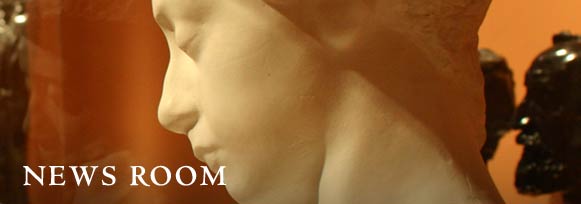Acclaimed Photographer Turns Lens on Early Supercomputers
Lee Friedlander: The Cray Photographs
March 27–June 16, 2013
Stanford, Calif. — Images by one of the nation's most influential photographers bear witness to the supercomputer industry in “Lee Friedlander: The Cray Photographs.” The series, rarely seen in its entirety, includes 79 works by an artist lauded for his straight-forward documentation of ordinary things. The exhibition opens at the Cantor Arts Center, Stanford University on March 27 and continues on view through June 16.
In 1986 Cray Research, Inc., then the world’s top supercomputer producer, invited American photographer Lee Friedlander (born 1934) to visit its worksite in Chippewa Falls, Wisconsin and take photographs for a book marking Cray’s 15th anniversary. This exhibition features the vintage gelatin silver prints in the resulting set, Cray at Chippewa Falls, Wisconsin.
The Cray project was a logical extension of Friedlander’s past street photography and his scenes of people hard at work in factories and data-entry centers. It includes a range of subjects shot in Friedlander’s characteristic style: sober images of shop fronts and empty streets, views of the landscape and underbrush surrounding Chippewa Falls and close-up shots of workers. In many of the Cray photographs, he focused on the women performing fine-motor tasks such as installing the complex wiring inside a massive supercomputer. Interestingly, Cray founder Seymour Cray selected these women for their dexterity and talent in weaving and other fabric crafts.
As a whole, Friedlander’s photographs offer a complex and poignant portrait of the human, artificial and environmental components that made Cray Research what it was in 1986. The images have great historical significance as well. In 1996 Cray’s company merged with Silicon Graphics, Inc. of Mountain View, California; Silicon Graphics helped spark the rise of Silicon Valley and its radical transformation of global tech culture.
The set of works in the exhibition is the partial and promised gift of Michael J. Levinthal (Stanford BS ’76, MS ’77, MBA ’81). The exhibition is made possible by support from the Levinthal Family, given in memory of Elliot Levinthal; the Betsy and Thomas Gates Fund for Photography; Cray Inc.; and Cantor Arts Center members.
Visitor information
The Cantor Arts Center is open Wednesday–Sunday, 11 am–5 pm, Thursday until 8 pm. Admission is free. The Cantor is located on the Stanford campus, off Palm Drive at Museum Way. Parking is free after 4 pm. weekdays and all day on weekends. Information: 650-723-4177, museum.stanford.edu
# # #
About the Artist
Lee Friedlander was born in Aberdeen, Washington, in 1934 and studied at the Art Center of Los Angeles in the early 1950s. In 1956 he moved to New York, where he worked freelance and took jobs photographing jazz musicians. During the 1960s, primarily using Leica 35mm cameras and black and white film, Friedlander started photographing the American urban environment. His coolly detached images captured the feel of modern society. He developed a visual language that included images of people at work, landscapes framed by car windows, shop fronts with odd juxtapositions of signs and merchandise, and deliberately awkward self-portraits. He featured prominently in curator John Szarkowski’s landmark 1967 exhibition “New Documents” (Museum of Modern Art, New York), and today he is regarded as one of America’s most influential photographers.
Friedlander has received numerous awards, including multiple Guggenheim Memorial Foundation Fellowships and National Endowment for the Arts Grants, and a MacArthur Foundation Award; he also is a Fellow of the American Academy of Arts and Sciences and the French Chevalier of the Order of Arts and Letters. His works are in the collections of major museums including the Metropolitan Museum of Art, New York, and the Museum of Modern Art, New York, the Victoria and Albert Museum in London, the Center for Creative Photography in Tucson, and the George Eastman House in Rochester, New York.
Notes to Editors
• To arrange interviews and for further information, contact Anna Koster, Head of Communications, Cantor Arts Center, 650-725-4657, akoster@stanford.edu
• For high-resolution publicity images, contact PR Assistant Manager Margaret Whitehorn, Cantor Arts Center, 650-724-3600, mmwhite@stanford.edu
About the Cantor Arts Center
Take a journey around the world: from Africa to the Americas to Asia, from classical to contemporary. There is so much to discover at the Cantor. With 24 galleries plus sculpture gardens, collections that span 5,000 years, a world-famous Rodin collection, changing exhibitions, frequent tours and free programs, there is something for everyone at the Cantor. And admission is free for everyone.

Lee Friedlander, Cray at Chippewa Falls, Wisconsin,
1986. Gelatin silver print. Gift of Michael J. Levinthal, Cantor
Arts Center, 2012.224.1. © Lee Friedlander, courtesy of Fraenkel Gallery, San Francisco

Lee Friedlander, Cray at Chippewa Falls, Wisconsin, 1986. Gelatin silver print. Gift of Michael J. Levinthal, Cantor
Arts Center, 2012.224.2. © Lee Friedlander, courtesy of
Fraenkel Gallery, San Francisco



